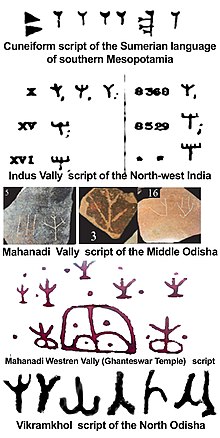Kalinga script
[3][4][5] The Hathigumpha inscription at Udayagiri caves in Bhubaneswar is written in the deep-cut Brahmi script[6] which is also known as Early Kalinga Type.The idea of ascending the throne of Kalinga in Sinhala as a region close to Tamil and introducing the agriculture and education system further reinforces this view.Evidence of a similar connection to the southern Votiprolu script has been found in Lalitgiri, Radhanagar fort in Odisha.During this time, independent kings began to change the appearance of the script, especially in places, with the introduction of puda, tails, and so on.Deciding from the developed and practical effective period that Brahmi had attained, Hiralal Ojha was not in support of impute its basis to any peripheral stating point or ascendancy.He advised the addition of the script without any remarkable change approximately from 500 BC to AD 350 where after two disconnect brooks of writing bifurcated from its main source.The southern part was divided into the western, the central provincial, Telugu-Kannada, Grantha, Kalinga and Tamil scripts.[22] The copper plates of the early Gangas of Kalinganagara show a fundamental difference from the style of writing seen in the earlier groups.


AbugidaOdia languageEgyptianProto-SinaiticPhoenicianAramaicBrahmiSiddhamSharadaTibetanBhaiksukiphonetic transcriptionsInternational Phonetic AlphabetBrahmic scriptsBrahmi scriptGurmukhiKhojkiKhudabadiMultaniMahajaniKamarupiNagariDevanagariGujaratiNandinagariKaithiSylheti NagriBengali–AssameseBengaliAssameseTirhutaNepaleseBhujimolRanjanaSoyomboPracalitMeiteiLepchaPhagspaZanabazar squareMarchenTamyigTocharianBhattiproluTamil-BrahmiPallavaGranthaMalayalamTigalariDhives AkuruSaurashtraSinhalaKhom ThaiSukhothaiFakkhamThai NoiTai VietLai TayBalineseJavaneseOld SundaneseSundaneseLontaraMakasarUlu scriptsLampungRejangBaybayinHanunooTagbanwaKulitanMon–BurmeseBurmeseChakmaS'gaw KarenTanchangyaKhamtiTai LeModern MonTai ThamNew Tai LueVatteluttuKolezhuthuMalayanmaKadambaTelugu-KannadaKannadaGoykanadiTeluguBrahmic scriptOdishaKalingaEastern Ganga dynastySomavamshi dynastyAnantavarman ChodagangaSiddhaṃ scriptOdia scriptHathigumpha inscriptionUdayagiriKharvelSatrubhanjaGupta scriptRatnagiri, OdishaGrammarBaleswariGanjamiSundargadiSambalpuriKalahandiaPhulbaniSinghbhumiBodo ParjaBhatriKaraniNumeralsOdia BrailleLiteratureChautisaWritersSahitya Akademi AwardSahitya Akademi Translation PrizeYuva PuraskarOdisha Sahitya AkademiOdisha Sahitya Akademi AwardAtibadi Jagannath Das AwardOdissi music